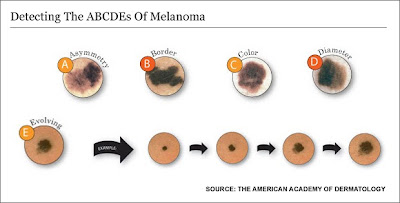- A - Asymmetrical shape: a shape that is not even
- B - Border: an irregular border that is difficult to define
- C - Color: more than one color or an uneven distribution of color
- D - Diameter: a diameter greater than 6 millimeters
- E - Evolution: recent changes in color and size
However, one recent study reveals that many young patients with melanoma do not demonstrate symptoms falling within the ABCDE detection criteria.
Scientists at the University of California, San Francisco, studied
60 pediatric patients with melanoma and 10 pediatric patients with ambiguous
melanocytic tumors (tumors that contain both benign and malignant melanomas). The
patients were put into two groups: Group A was diagnosed before the age of 10,
and group B was diagnosed between ages 11 and 19.
Sixty percent of patients in group A and 40 percent in group
B did not have conventional ABCDE characteristics of melanoma. Instead,
researchers found that the following characteristics were more common: amelanosis
(a lack of melanin in the skin), bleeding, bumps, variable diameter, uniform
color and de novo moles (moles that are just beginning to form).
In all, 44 percent of the pediatric patients’ skin cancer
was unclassifiable using the ABCDE method.
Although these are scary statistics, there are ways to
reduce your child’s risk of getting skin cancer. Be sure to slather kids in a
UVA- and UVB-blocking sunscreen any time they go outside. Hats and clothing are
useful to protect kid’s skin from the sun. Children also need to be checked
regularly by a dermatologist. Greenville Dermatology’s new MelaFind machine can
help discover irregular moles faster than before. To schedule an appointment
with Greenville Dermatology, call us today at (864) 242-5872.




